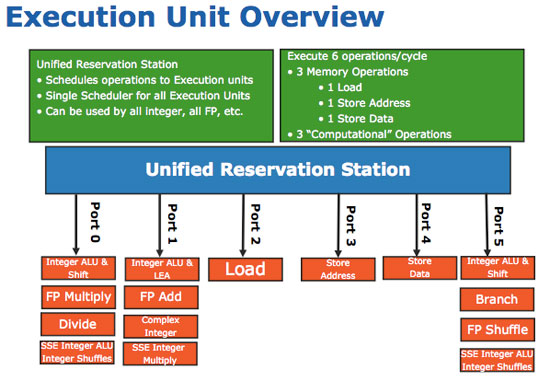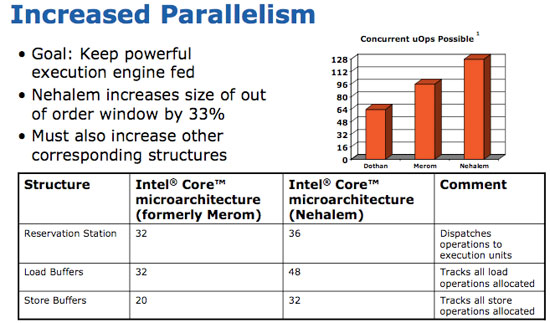Nehalem - Everything You Need to Know about Intel's New Architecture
by Anand Lal Shimpi on November 3, 2008 1:00 PM EST- Posted in
- CPUs
Finish Him!
The execution engine of Nehalem is largely unchanged from Penryn; just like the front end was already wide enough, so was the execution end of the architecture:

Intel did however increase the size of many data structures on the chip and increase the size of the out of order scheduling window. Nehalem can now keep 128 µops in flight, up from 96 in Conroe/Merom/Penryn.

The reservation station can now hold 36 µops up from 32; both load and store buffers have increased from 32 and 20 to 48 and 32 entries, respectively.
Nehalem may not be any wider than Conroe/Penryn, but it should make better usage of its architecture than any of its predecessors.
Understanding Nehalem’s Server Focus (and Branch Predictors)
New TLBs, Faster Unaligned Cache Accesses










35 Comments
View All Comments
defter - Friday, August 22, 2008 - link
Links are 20-bit wide, regardless of encoding or whether 1,2,8,16 or 20 bits are used to tranmist the data.I wonder who is flamebaiting here, a previous poster just mentioned the correct link width, he wasn't talking about "usable speed".
rbadger - Thursday, August 21, 2008 - link
"Each QPI link is bi-directional supporting 6.4 GT/s per link. Each link is 2-bytes wide..."This is actually incorrect. Each link is 20 bits wide, not 16 (2 bytes). This information is on the slide posted directly below the paragraph.
JarredWalton - Thursday, August 21, 2008 - link
It's 20-bits but using a standard 8/10 encoding mechanism, so of the 20 bits only 16 are used to transmit data and the other four bits are (I believe) for clock signaling and/or error correction. It's the same thing we see with SATA and HyperTransport.ltcommanderdata - Thursday, August 21, 2008 - link
Since the PCU has a firmware, I wonder if it will be updatable? It would be useful if lessons learn in the power management logic of later steppings and in Westmere can be brought back to all Nehalems through a firmware update for lower power consumption or even better performance with better Turbo mode application. Although a failed or corrupt firmware update on a CPU could be very problematic.wingless - Thursday, August 21, 2008 - link
I thought about this when I read about it the first time too. Flashing your CPU could kill the power management or the whole CPU in one fell swoop!